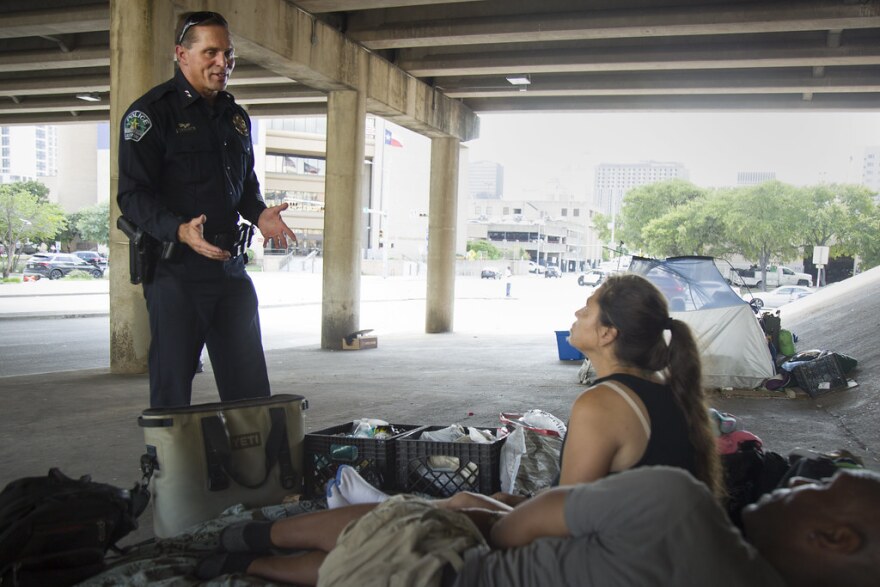Threats of state intervention, confusion on the part of officers and indecision on the dais at City Hall have all led the Austin Police Department to rethink how it enforces laws regulating where people can sit, lie down and camp in public.
New training bulletins out Thursday give officers more clarity (and latitude) in how they approach obstruction of public areas and their ability to interact with people violating the city laws. Those laws essentially allow camping or resting public, unless someone is completely or willingly obstructing a sidewalk – or if they pose an immediate health or safety risk.
RELATED | Manley Suggests Reinstating Bans On Camping And Resting In Public While New Rules Are Worked Out
All this is to say, Austin police haven't been sure about how to enforce the new rules. Police Chief Brian Manley said back in June, before the rules went into effect, that it may be difficult for officers to determine the threshold for potentially dangerous behavior. At a press conference Thursday, he said he's asked the Austin City Council to revert to the old laws that banned camping in public and sitting or lying down in the downtown area.
But he also issued two training bulletins for how police should handle cases in which people are unsafely camping in public or obstructing sidewalks.
The advisories provide operational clarity and updates on three fronts: notification, enforcement and documentation.
Notification
The department issued its first guidelines on how to enforce the rules in July. For both camping and obstruction, the department stated officers had to issue a warning, then give a "reasonable" amount of time for compliance. Though, the training bulletins noted, "a reasonable amount of time will depend upon the circumstances," depending on whether something posed an immediate danger.
New guidelines still have that "reasonable amount of time" requirement, but offer clarification on situations in which a person camping or resting may not be able to immediately break down an encampment or pack up their things. As with the former rules, officers are allowed to remove obstructions and items in an encampment. The revised guidelines also require that repeat offenders be given a warning for each new violation.
Enforcement
APD's new training bulletin drills down into how police can enforce the rules by providing more insight into how to approach people or camps that block or obstruct sidewalks and rights of way. It splits enforcement into whether something is endangering or merely blocking.
The previous guidelines offered some specifics on this, saying officers could ticket people for obstruction or camping if "a person, structure or bulky item" blocks a pedestrian from using a sidewalk and causes them to veer into a street to get around a camp or an encampment.
But the new rules break down what behavior qualifies as endangering or blocking.
Endangering
Officers say they can ticket someone for behavior that immediately endangers. So, an officer can ticket someone for either obstruction or camping if they or their belongings require someone to walk in a street to get around them, but also if a pedestrian has to step over belongings or people, or if items or belongings block the entrance or exit from a building to a sidewalk.
Then there are ticket-specific circumstances for both obstruction and camping, as it relates to endangerment.
For obstruction, someone could be ticketed for obstructing a sidewalk on a street that's closed for an event or for safety reasons.
For camping, someone could be ticketed for making a fire under a highway, using flammable materials or lighting a fire under a burn ban, camping in a creek bed or flood-prone area or camping close enough to a road "where there is a substantial risk that a car could leave the roadway and strike a person camping."
Officers can also cite someone for endangering behavior under the camping ordinance if they're using mattresses, upholstered furniture or furniture that's not OK for outdoor use.
Blocking
For both camping and obstructing, police could ticket someone if they block a sidewalk or space in a way that prevents people using wheelchairs from passing normally. (The same goes for people with strollers or shopping carts.) The previous guidelines did not account for situations in which people using wheelchairs couldn't use sidewalks because of people or belongings blocking their way.
Officers can also ticket if people or belongings block a straight path; "people cannot create a 'zig-zagging' obstacle course on a sidewalk," the training bulletins read. People or belongings also can't block or obstruct things on sidewalks, like parking meters, fire hydrants, bus stops or benches.
Documentation
Not much has changed here, compared to the last round of guidelines for officers. Ticketing officers are still required to note the amount of time they've given to someone who's been warned. The difference is officers are required to take pictures of "observable conditions that constitute the offense."








